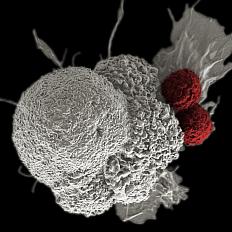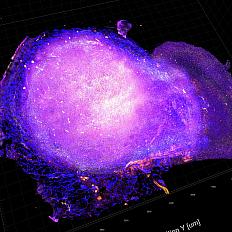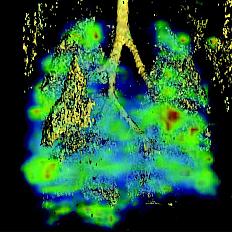You are here
October 12, 2017
Multimedia: Partnership for Accelerating Cancer Therapies
-
PACT Press Conference
NIH partners with 11 leading biopharmaceutical companies to accelerate the development of new cancer immunotherapy strategies for more patients.
-
NIH partners with 11 leading biopharmaceutical companies to accelerate the development of new cancer immunotherapy strategies for more patients.
(Source: NIH)
-
Cancer Immunotherapy
Shown here is a pseudo-colored scanning electron micrograph of an oral squamous cancer cell (white) being attacked by two cytotoxic T cells (red), part of a natural immune response. Nanomedicine researchers are creating personalized cancer vaccines by loading neoantigens identified from the patient's tumor into nanoparticles. When presented with immune stimulants, this activates the patient's own immune system, leading to expansion of tumor-specific cytotoxic T cells. (Source: National Cancer Institute \ Duncan Comprehensive Cancer Center at Baylor College of Medicine)
-
Anti-Tumor Immune Response
Using a novel imaging technique called transparent tumor tomography that three-dimensionally visualizes the tumor microenvironment at a single cell resolution, researchers obtained this image from a mouse model for HER2-positive breast cancer. Shown are cytotoxic T cells (CD3 in yellow; CD8 in red; , CD31 in blue) attacking the tumor after treatment with radiation and a PD-L1 immune checkpoint blockade therapy. New knowledge about the mechanism of inducing anti-tumor immune responses may lead to better treatments. (Source: National Cancer Institute \ Univ. of Chicago Comprehensive Cancer Center)
-
Novel Multimodality Imaging Approaches to Target Metastatic Cancers
The Center of Cancer Nanotechnology Excellence at Johns Hopkins University is focused on nanotechnology-based in vitro assays, targeted chemotherapy, and immunotherapy for lung and pancreatic cancers. Utilizing their metastatic model of melanoma, the image shown here is a fusion of lung (CAT scan, in solid yellow) and their molecular-genetic imaging technique that highlights the metastatic lesions (SPECT image, covering from blue-to-red that correlates lesion density).(Source: Camazine Scott)
This page last reviewed on October 16, 2017





